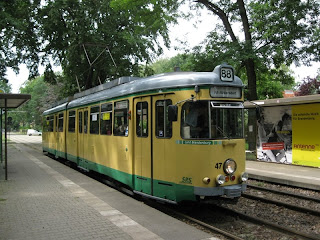
A picture that typifies the tramway, ex-Lisbon tram 24 runs along the sea wall at Puerto de Soller framed on both sides by palm trees
Majorca’s only surviving tramway links the terminus of the the Palma – Soller railway at Soller with Puerto de Soller (Port of Soller) on the island’s northern coast, 4.8 kilometres away. The line opened in October 1913 and still uses its original stock, albeit supplemented over the years by some second hand trams, and remains an important link between the town and the port. Bizarrely it is believed that the line was only constructed in the first place in order to extend the 27km long Palma – Soller railway over the 30km mark, thus making the whole line from Palma eligible for financial assistance from the government. However, and despite this tenuous reason for construction, the tramway has thrived.
The railway line from Palma, Majorca’s capital, to Soller was opened in 1912. Originally steam powered, the route was converted to electric traction in 1929 as its route passes through several long tunnels which made steam rapidly become very unpopular. The 1929 built passenger carrying electric locos still power the stock along the scenic route as it climbs out of Palma, which involves some street running for the first part, and towards the Sierra de Alfabia mountains before falling towards the coast. The railway was for many years the principal means of getting to Soller as the mountain range was bisected only by the railway and one tortuously winding mountain road. However, from 1996 a new road tunnel has opened up the area considerably. Despite this, it is by rail that most tourists will arrive in Soller.
Operated, as is the railway, by
Ferrocarril de Sóller , the tramway was originally equipped with three motor cars, nos. 1-3, and two matching trailers originally numbered 7 and 8 but later 5 and 6. Built by Carde & Escoriaza in Zaragoza, and on Brill 21E trucks, these 1913 veterans remain on the line today. In the summer they often run with coupled pairs of open ‘jardinera’ trailers, four of which were acquired from Palma when their system closed in 1954. Numbered 8-11 at Soller they were former horse cars which are believed to date from around 1890. A fourth motor car and matching trailer were obtained second hand from Bilbao in 1959, which became numbers 4 and 7 respectively, although these have since returned to Bilboa for preservation. The most recent second hand acquisitions have been five of the ‘700 series’ motor cars from Lisbon in Portugal, now numbered 20-24, with four of these known to be 716, 718, 725 and 729. These have been re-gauged to 3ft, which was the former Majorca standard and is retained throughout the railway and tramway between Palma and Puerto de Soller, although other lines on the island have been converted to metre gauge in recent years. Other Lisbon cars acquired, but not converted for use, have been similar two axle cars 704 and 734, and four axle cars 334 and 807. The former Lisbon trams were at first operated in basically original condition but have recently almost all been modified to resemble the home fleet which has involved replacing the side panelling with varnished ‘matchboard’ planks and painting the remainder in the familiar Soller orange and brown. More recently, and to cope with the problems frequently encountered when a packed train attempts to disgorge its passengers onto the tiny trams, some larger bogie trailers have been built to a traditional style, but much larger proportions making them appear slightly ungainly.

One of the new trailers is seen outside the tram depot whilst cars 2 and 20 look on. Notice the line to the left of the shed which is actually the railway line towards Palma
The single line Soller tramway provides an attractive ride between the town and the port. Beginning close to the tram depot at an interchange with the railway, to which the line is physically connected at this point, the first section of the tramway is in the street, running through Soller’s main square. After this it moves to a roadside reservation and through a passing loop which is not needed unless more than a half hourly service is running. The line passes through orange and lemon groves and then crosses the main Soller – Port road reaching the half way passing loop which is regularly in use. After this the line continues alongside the road, passing a disused loop, before approaching the impressive bay at Puerto de Soller from the west side. The tramway then runs around almost the full length of the bay, which is framed by palm trees, before terminating at the east side on a double track run-round loop. A headshunt extends beyond this which is ofter used for stabling a car between the peaks. The tramway runs all year round with a basic hourly frequency in operation during the winter, requiring just one tram and trailer set, whilst the frequency is doubled in the summer with two sets normally in use. The layout of the line does not allow for much improvements in frequency. Running time is about 20 minutes each way. Tickets are available from conductors on board the trams with one way journeys priced at 4 euros.

For more information and train and tram times/fares visit http://www.trendesoller.com
Written and Illustrated by James Millington

















